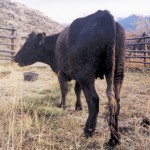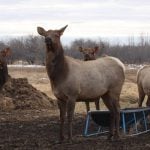
Tag Archives foot rot

Analyzing lameness in beef cattle
Research on the Record with Reynold Bergen
Cattle get lame for a lot of reasons, including injury, poor conformation, grain overload, mycotoxins (e.g. ergot) and bacterial infection. Different types of lameness need to be treated differently. Antibiotic treatment only helps if a bacterial infection is involved. Lameness is the second leading reason (behind bovine respiratory disease) that feedlot cattle are pulled and given […] Read more

The link between toe tip necrosis in cattle and flooring
Flooring that provides traction without scraping hooves minimizes the risk of white line separation in cattle
Toe tip necrosis syndrome is a hind-limb lameness of feedlot cattle that develops days to weeks after arrival at the feedlot. This disease is also known by many other names: toe abscess, toe ulcer, P3 necrosis, toe necrosis, apical white line disease, apicus necrotica, and the list goes on. The disease was first described in […] Read more

Toe-tip necrosis in cattle
Don’t overlook this disease when diagnosing lameness in the feedlot
Several things can cause foot soreness in cattle, including foot rot, puncture wounds, sole bruises, abscesses and white line disease. But one of the most serious is infection of the inner parts of the foot, resulting from toe-tip necrosis. Dr. Murray Jelinski of the Western College of Veterinary Medicine at the University of Saskatchewan started […] Read more

Vet Advice: Spot and treat foot rot early
Foot rot is an acute and highly infectious disease of cattle characterized by swelling and lameness. The condition is extremely painful. If not treated promptly, the infection invades other structures in the foot including bones, joints and tendons, complicating treatment and delaying recovery. Foot rot originates between the claws of the hoof. It is more […] Read more

Fly bites a nuisance that can also lead to foot rot
Chemical controls and pasture rotation are options for control of stable flies
Fly problems are prevalent in some parts of North Dakota this year, North Dakota State University Extension livestock specialists warn. Horn, face and stable flies all are irritating to cattle, but stable flies have been particularly bothersome. “They will bite and irritate the animals on the legs and belly, and control of these pests is […] Read more

New drug targets pain from foot rot in cattle
Health: News Roundup from the May 2018 issue of Canadian Cattlemen
A new topical drug promising pain relief from a specific ailment affecting cattle is now available in Canada. Banamine transdermal, a non-steroidal anti-inflammatory drug (NSAID) produced by Merck Animal Health, was released at the end of January. This pour-on product, with flunixin meglumine as the active ingredient, is used to reduce fever related to bovine […] Read more

Not all lameness is foot rot
Animal Health: Two things need to be present for foot rot to occur
Foot rot is an infectious disease that causes swelling, pain, heat and inflammation in the foot, resulting in severe lameness that appears suddenly. The opportunistic pathogens require a break in the skin, however, to enter the foot. The main bacterium we deal with is Fusobacterium necrophorum. Importance of diagnosis Lameness may be from a nail […] Read more

Toe tip necrosis syndrome in cattle
Research on the Record with Reynold Bergen
Lameness is the second most costly feedlot health issue after bovine respiratory disease. Aside from treatment and death losses, lame cattle eat less, grow less, convert feed to gain less efficiently, and are more prone to transport injuries. Lameness is also a significant animal welfare concern and has been incorporated into some on-farm welfare audit […] Read more

Lameness in feedlot cattle
The problem can be easy enough to see, but tough to diagnose
A recent review of health records from 24 Alberta feedlots covering approximately 445,000 head revealed that lameness affected 6.1 per cent of the animals, but accounted for 28 per cent of all treated animals and 49 per cent of euthanized animals, while incurable respiratory disease accounted for 10 per cent. The finding, which was part […] Read more

The importance of field diagnosis
Health: The most common reason a treatment fails is due to a wrong diagnosis
If an animal has a health problem, it’s crucial to have the correct diagnosis before attempting treatment. Dr. Chris Clark of the Western College of Veterinary Medicine in Saskatoon says the most common reason that a treatment fails is a wrong diagnosis. “We often complain about disease not responding to treatment. But the drugs we […] Read more



